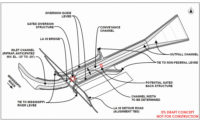Oil Port Proposed Next to Louisiana River Diversion Moves Forward

A state agency has determined that an oil port, proposed just north of the Mid-Barataria Diversion, is not inconsistent with plans for the diversions, intended to shore up wetlands south of New Orleans.
PHOTO COURTESY OF CPRA
A $2.5 billion oil export terminal planned for the Mississippi River in Louisiana is one step closer to construction following a preliminary OK from a state agency building an adjacent river diversion.
The Plaquemines Liquids Terminal (PLT) is planned for the west bank of the Mississippi River, south of New Orleans, and is expected to create at least 1,250 temporary construction jobs and 35 new direct jobs.
The PLT is one of at least seven oil export terminals that have been proposed along the Gulf Coast – most of them in Texas —since Congress lifted the 40-year-old ban on oil exports in 2015. The terminals are meant to take advantage of the growing amount of crude oil created by hydraulic fracturing.
While all of the ports have to be permitted by state, local and federal agencies, the PLT had one additional hurdle—to ensure that it was consistent with Louisiana’s $50 billion coastal master plan intended to reduce the state’s land loss. The port would be immediately north of the $1.4 billion Mid-Barataria Sediment Diversion, and just south of the Alliance Refinery.
On April 26, the Louisiana Coastal Protection and Restoration Authority conditionally deemed the project “not inconsistent” with Louisiana’s coastal master plan. The determination is conditional, meaning the project must comply with certain restrictions and mitigation requirements to prevent sediment loss and environmental problems, such as oil spills that could affect the nearby Barataria Bay wetlands. The state is requiring PLT to pay for a sediment study that will inform these requirements. AECOM, the contractor overseeing the diversion’s design, will perform the study.
“PLT has agreed to coordinate with CPRA during the design phase of the project to ensure construction will not have an impact on the (sediment diversion) project,” says Megan Terrell, deputy director of the Governor’s Office of Coastal Activities.
But environmental groups disagree with the CPRA’s conclusion.
“We previously opposed a coal export terminal which was proposed to be in the same location for similar reasons. We do not oppose a new crude oil export terminal in Plaquemines Parish. What we oppose is a new crude oil export terminal located directly upriver of the most important coastal restoration project in the state’s history,” said Emily Vuxton, policy director for the group the Coalition to Restore Coastal Louisiana in a statement.” We believe that the operation of this new terminal could cause the diversion to be less successful in capturing sediment. Oil spills could also be disastrous to the marsh area that will be sustained by the diversion.”
The terminal is a joint project of Tallgrass Energy LP and Drexel Hamilton Infrastructure Partners. A Tallgrass Energy official said officials are still commercializing the project and have yet to determine a final design or begin the bidding process. When the project was announced in August 2018, Tallgrass said it could be operational in the second quarter of next year.
The terminal will be fed by a pipeline that can transport up to 800,000 barrels of crude oil per day from Cushing, Okla., to Louisiana. Tallgrass Energy also plans to build an offshore pipeline extension to give the terminal the added capability of loading the largest petroleum tankers currently in use.
The project’s permit application calls for construction of oil storage tanks to hold up to 20 million gallons of oil, a dock and a rail offloading facility. The terminal will consist of multiple deep-water docks along the river to be furnished by the Plaquemines Port Harbor & Terminal District. These facilities will enable terminal operators to load and unload larger-capacity vessels now traversing the recently expanded Panama Canal.
“Plaquemines Liquids Terminal LLC has been – and will continue to be – committed to being a good neighbor in Louisiana,” says Jason Reeves, general manager of Tallgrass Terminals LLC. “The Coastal Protection and Restoration Authority found that our project is consistent with the master plan, which we view as validation of our intent to minimize and mitigate any affect (the terminal) might have on the Mid-Barataria Sediment Diversion Project.”

